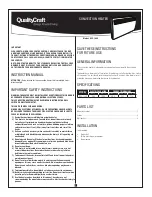
10 | PRODUCT DATA
MUL
TI V S Three-Phase Outdoor Unit Engineering Manual
'XHWRRXUSROLF\RIFRQWLQXRXVSURGXFWLQQRYDWLRQVRPHVSHFL¿FDWLRQVPD\FKDQJHZLWKRXWQRWL¿FDWLRQ
©
/*(OHFWURQLFV86$,QF(QJOHZRRG&OLIIV1-$OOULJKWVUHVHUYHG³/*´LVDUHJLVWHUHGWUDGHPDUNRI/*&RUS
Outdoor Unit Controls
Outdoor units are factory wired with necessary electrical control
components, printed circuit boards, thermistors, sensors, terminal
blocks, and lugs for power wiring. The control wiring circuit is
low voltage and includes a control power transformer, fuses, and
interconnecting wiring harness with plug connectors. Microprocessor
based algorithms provide component protection, soft-start capability,
refrigeration system pressure and temperature control, defrost,
and ambient control. The unit is designed to provide continuous
compressor operation to -9.9°F in cooling mode with optional low
ambient wind baffle.
When the system is started, the connected indoor units are
automatically assigned an electronic address by the outdoor unit’s
microprocessor. Additionally, each indoor unit is capable of accepting
a manual assignment of a secondary electronic address that, if used,
provides unit tag identification when integrating with LG VNet control
devices.
While operating in Heating mode, the outdoor unit has a demand
based defrost control algorithm and a refrigeration system pump
down cycle designed to store refrigerant in the outdoor unit up
to 13.2 lbs. (6-, 8-ton). In Heating mode, a cooperative control
algorithm automatically balances, in real-time, the distribution of
refrigerant to the indoor units when the system’s refrigerant mass
flow is insufficient to satisfy the demand of all indoor units when
the system is called on to operate outside the system design
parameters.
In 10-second intervals, the outdoor unit microprocessor will record
the last three minutes of system run-time data in non-volatile
memory. Upon unit malfunction, or a power outage that results in
a system shutdown, the stored system operational data can be
retrieved and analyzed to assist in diagnosing a system malfunction.
The outdoor unit microprocessor is provided with a three-digit,
LED display that communicates active system information and /
or malfunction codes. The microprocessor has an algorithm that
actively verifies the operational condition of system sensors and
thermistors. A refrigerant auto-trim-charge algorithm assists the
installer with properly charging the system.
A power conditioning circuit is provided and designed to protect the
unit’s inverter compressor and outdoor unit fan motors from phase
failure, phase reversal, sense an under-voltage or over-voltage
condition, and to prevent transmission of power irregularities to
the supply power source. A snow throw algorithm is provided and
designed to reduce snow buildup on the discharge side louvers grille
at regular intervals.
MECHANICAL SPECIFICATIONS
THREE-PHASE











































